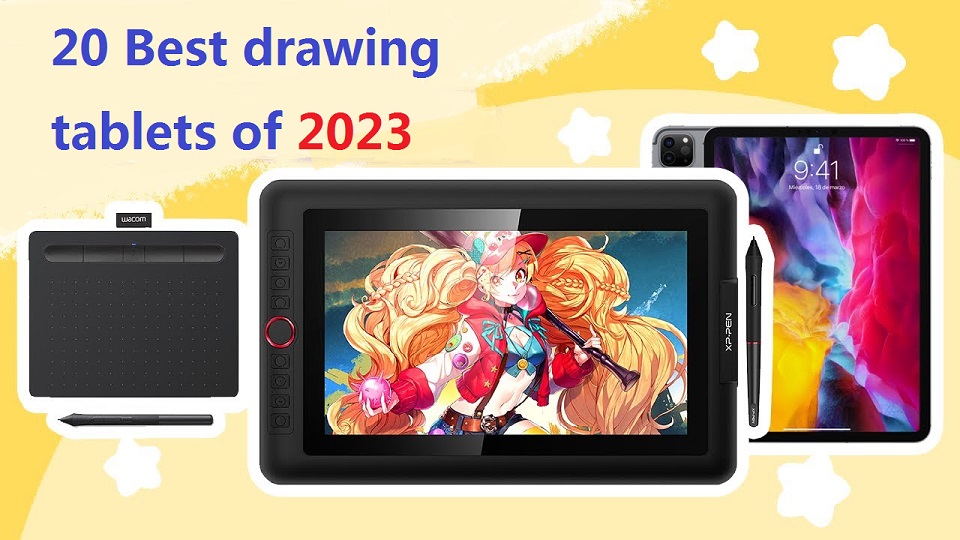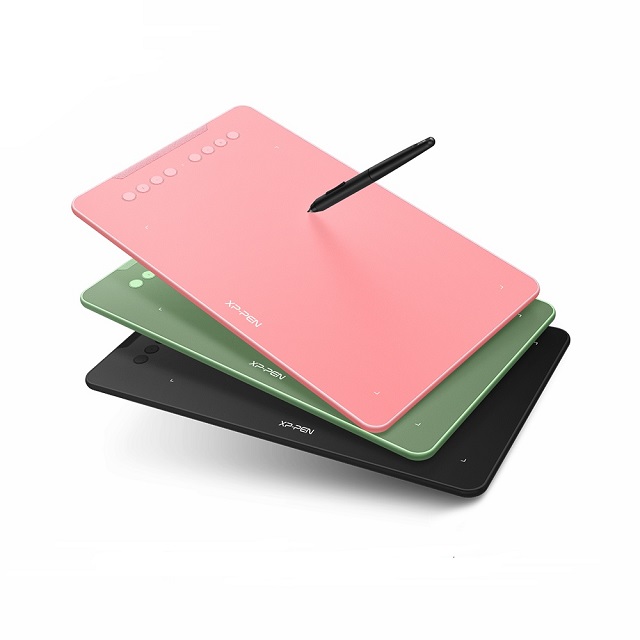
Tablets, Phones and Laptops Test y Review
We help you choose best products
Best drawing tablets for digital artists and graphic designers

When you're drawing, painting or retouching photos on a computer, a mouse is only going to get you so far. It is a lot easier to draw or retouch photos with a pen tablet than with a mouse.
Drawing Tablets have become an essential tool for artists, graphic designers, photographers, and digital illustrators. It allows you to interact with a drawing program such as Krita or Photoshop.
These drawing tablets are usually equipped with highly sensitive digitizers and stylus or even screen. You can draw images and graphics in a breeze.
By using a drawing tablet and computer program you can select from all sorts of different tools and settings. Choose from endless brushes including watercolour, calligraphy and even chalk. Then there are the limitless colour selections on offer.
With an unique design and powerful features, these devices allow unparalleled precision and flexibility in artwork creation.
What's the best drawing tablet in 2023? Drawing tablets are so good these days, and while it's great having so many excellent options to choose from, it also means that finding the perfect one for you can be a challenge.
To make sure you get the most for your investment, we've picked out the best of the best.
Some drawing tablets below may be pricey, but they deliver excellent daily performance and great digital pens and will keep on running well into the foreseeable future.
If you're looking to spend a little less and still get the best tablet on a budget, you can find something really good for under $100.
Thus, the best graphic tablet is described below. I think you'll find something on this list that'll suit you perfectly.
What is a Drawing Tablet ? 3 Main Types of Graphics Tablets
For those who have never used a drawing tablet (sometimes called a graphics tablet or pen tablet), it is a computer input device where you draw with a stylus (also called a pen) on a flat surface tablet.
When digital painting with a brush tool, the advantages of using a graphics tablet really become apparent. With a pressure sensitive pen you can control the thickness and opacity of brush strokes in graphic software like photoshop or illustrator.
The amazing pressure sensitivity mean that as you draw, a line can go from thin to thick depending on how hard you press the pen tip—much like a pencil. and they can even change angle as you tilt the pen (much like a calligraphy pen).
Drawing tablets come in three forms: drawing tablet without screen, drawing tablet with screen and standalone drawing tablet.
Non-Screen Drawing Tablet
In and of itself, it does not display anything graphically. Usually, the tablet's active surface mapped to the display of the monitor. Whatever you draw on the tablet surface shows up on your computer screen.
Notably, Screenless graphics tablets are relatively inexpensive and perfect for beginners. But there is a learning curve of feeling your pen position on the tablet with what you are seeing on your monitor or other display device.
Pen Display Monitor
While display drawing tablets are more expensive, they're a bit more intuitive because you draw directly on the screen with a stylus.
Unlike standalone drawing tablets, they still need to be hooked up to a computer—because they onle a monitor and have have no cpu, ram, rom and other components.
Standalone Drawing Tablet
There are also plenty of all in 1 tablets support pen input for artists, that allow you to draw straight on the screen of the computer.
You'll not need any additional computer to use the standalone drawing tablet. The device's compact and lightweight design also makes it easy to carry around and drawing on the go.
Users are likely more familiar with this type: Windows, iOS and Android tablets like microsoft surface pro, apple ipad and samsung galaxy tab. These are the most expensive options!
20 Best graphics drawing tablets in 2023

Are you looking for the best tablets for graphic design or digital art? Whether that be for illustration, photo editing, drawing or art, we've got you covered!
Listed below are some of the most popular options available in the market that will get your job done instantly and perfectly.
1. One by Wacom (CTL-472)
2. Wacom Intuos Small
3. Gaomon S620
4. XP-Pen Deco 01 V2
5. Huion H610 Pro V2
6. Wacom Intuos Pro Medium
7. XPPen Deco Pro
8. Wacom One
9. XPPen Artist 12 (2nd Gen)
10. Huion Kamvas 13
11. Wacom Cintiq 16
12. Huion Kamvas 16 Pro (2.5k)
13. XPPen Artist 15.6 Pro
14. Wacom Cintiq 22
15. Huion Kamvas 22 Plus
16. XPPen Artist 24 Pro
17. Huion Kamvas Pro 24
18. iPad Pro (2022)
19. Samsung Galaxy Tab S8 ultra
20. Microsoft Surface Pro 9
Drawing Tablet Buyer's Guide: Key Features & Specs to Look For
There are a lot of factors that impact the quality and functionality of a drawing tables.
Here are a few of the most important:
Compatibility
The operating system is a program that is responsible for the working of any device. You must be familiar with Windows, Mac, and Linux- these are a few popular operating systems that run on most devices, they are built for high-end graphic or animation design software.
When it comes to drawing tablets, the choice is mostly between Mac and Windows. So pay attention to the the drawing tablets' compatibility with Microsoft and Apple.
With the popularization of e-Learning, new drawing tablet models can work with Chromebooks and Android devices, but still not include the iOS devices.
Active Area
The active area on the drawing tablet is the space where you sketch, draw and edit. The active area should not be confused with screen size.
A bigger active area will enable you to work on larger drawings more easily without the need for zooming and panning.
If you do a lot of drawing on the go you may be better off with a more compact tablet that's easier to carry around.
The active area should not act as a constraint to your creative freedom, so choose wisely.
Resolution
Lines per inch or LPI index is a variant of resolution that is common in the drawing tablet jargon.
Larger non-screen drawing tablets typically have a greater resolution than smaller ones.
If your work involves designing highly detailed images, a higher LPI index is what you should look for.
Stylus
The stylus is a digital pen. Its purpose is to create a real pen/pencil-like experience for the designer.
There a majorly two kinds of stylus: Rechargeable lithium battery-operated stylus and EMR (Electron magnetic resonance) stylus.
Rechargeable styluses need charging just like your phone or laptop. They are usually slimmer and fit comfortably in your hand.
EMR styluses require no charge, and no batteries to power them. They use electromagnetic frequency that transfers power to the pen wirelessly right from the tablet.
This is a happy medium for people who love wireless accessories and don't want to keep replacing batteries.
Pressure Sensitivity
Before buying a drawing tablet, do look for this factor because the hardware mostly governs it. The numerical value starts from 1000 and goes to 8000 levels.
The advantage of going with a greater number of pressure levels is that it enables you to make finer distinctions in the thickness of the lines, which is essential when working on high-resolution drawings.
The ideal pen pressure is over 2000, but anything far exceeding that value will be hard to notice. The comfort of the pen in your hand will be up to your preferences, so it's nice if you can try before you buy but that's not always possible.
Most devices come with a setting for modulating this parameter. You can set the screen sensitivity to some extent, using this and use the most suited setting for your comfort.
Tilt Sensitivity
Tilt Sensitivity is a digital tablet feature that allows the device to perceive the angle of the digital pen over the tablet surface.
That data is used by the device software to react in consequence.
So, the resultant traces tent to look like it would do on physical work, according to each drawing tool used.
Tilt Sensitivity is a feature that comes with most of the latest generation of tablets.
Hotkeys
Hotkeys are the shortcuts that you can use to do your work faster, and smoother. They help you save time.
Many tablets come with a built-in scroll bar or scroll wheel to zoom in and out the canvas quickly. This directly affects the completion time of your work.
Wired or Wireless
Some non-screen drawing tablets connect to the computer using Bluetooth or WiFi (2.4GHz), both tech are norms for wireless transmission.
Wired drawing tablets do not give you the freedom of movement that wireless tablets do. However, wireless tablets require a good connection, and sometimes they will most likely work with a bit of a lag.
The choice between a wireless and a wired tablet depends totally on your requirements. If you move around a lot, go for a wireless tablet. If you prefer working on a desk, pick a wired drawing tablet.
Notice that the wireless technology does not have the high bandwidth that is required to transfer display and the pen data and that is why there is no wireless display drawing tablet (like wacom cintiq, xppen artist and huion kamvas) in the market.
If you specifically need a wireless or bluetooth drawing tablet with a screen, then you're options are limited to either a standalone device like the ipad pro, surface pro and samsung galaxy tab.
Screen Quality
Screen Size: The first thing you'll need to figure out is what screen size suits your needs. Most drawing tablet monitors range from 10-inch to 24-inch, measured diagonally from corner to corner. large or small size depending on how much space you've got on your desk.
Screen Resolution: Screen Resolution is the number of pixels (display units) on the screen. It is represented as A x B where A is the number of pixels in a row and B is the number of pixels in a column.
Each pixel can have a different color. A higher resolution guarantees a more accurate display and a more excellent opportunity to show different colors at the same time.
Pixel Density: PPI is a measure of the number of pixels per inch on a monitor. The higher the PPI, the more pixels there are in each inch of screen real estate, resulting in sharper and more detailed images.
PPI is calculated by dividing the number of pixels in the horizontal and vertical directions by the diagonal screen size of the monitor.
Screen Panel: IPS vs OLED are two giants of display technology that are currently dominating the industry.
IPS (in-plane switching) is a display standard developed for LCD panels. IPS allows for better colors, wider viewing angles, and a much higher picture quality over its competition (TN, VA).
IPS panels are highly recommended for artists due to the wide view angles and high color accuracy, though they are slightly more expensive than TN and VA panel.
OLED (organic light-emitting diodes) displays are a more modern standard, we're now slowly beginning to see some great OLED drawing monitors.
OLED displays are perfect for anyone seeking a visually engaging and immersive viewing experience due to the near infinite contrast ratio, deepest blacks, and ultra-fast refresh rates.
Color Gamut: The colour gamut reflects the range of colours that a monitor can output and defines its limits of saturation.
It indirectly shows the ability of the screen to reproduce the colors. The wider the gamut (), The more colors your panel can output, the more vibrant and saturated the colors can be.
The most commonly seen color gamut in drawing monitor world are sRGB, Adobe RGB,DCI-P3 and NTSC.
The Adobe RGB is substantially bigger than the DCI-P3 color gamuts, as well as Color Gamut sRGB which are both significantly smaller. Furthermore, 72 percent NTSC is almost equal to 100 percent sRGB in terms of color gamut.
Refresh Rate: A monitor's refresh rate is how often the image on the screen is updated per second, typically given as a number of Hertz, or Hz.
A refresh rate of 60Hz means that your display can redraw the entire screen 60 times in one second.
High refresh rate monitors update what's on the screen more often than slower refresh rate monitors.
For starters, a high refresh rate monitor feels smoother and looks more natural. This can be more comfortable on the eyes, too, because there's less imperceptible flickering.
Brands
Wacom is considered the premiere brand, high quality, and great driver support.
Huion and XP-Pen are relatively new contenders in the drawing tablet scene, but they have both quickly developed a name for themselves regardless.
In fact, they have both risen to the front of the pack side by side, so it's hard to tell which is actually the better brand.
They are both targeting the exact same audience: those who want professional grade drawing tablets without having to pay the premium that Wacom charges.
The following are the other five specialized graphics tablet brands: Gaomon, Ugee, Veikk, Xencelabs and Parblo. which are lower-cost tablet brands similar to the Huion or XPPen.
Conclusion
A drawing tablet is something you can make great use of whether you're are an experienced artist or just starting.
We recommend beginners to start out with a non-display tablet as these are generally the most affordable models. And they can still give you a feel for whether or not a drawing tablet is something you'll stick with long term.
Once you've gotten more comfortable with digital drawing it might be a good idea to upgrade to a built-in display tablet.
If you do a lot of traveling you may actually want to start with one of standalone drawing tablets like iPad Pro instead.
The best drawing tablet would be the one which fulfills all your requirements.
You don't need to waste a lot of time on the many options. Just look at options with a discerning eye, and you'll find your dream drawing tablet.